Logic Pro X: How to Create and Use VCA Faders and VCA Groups
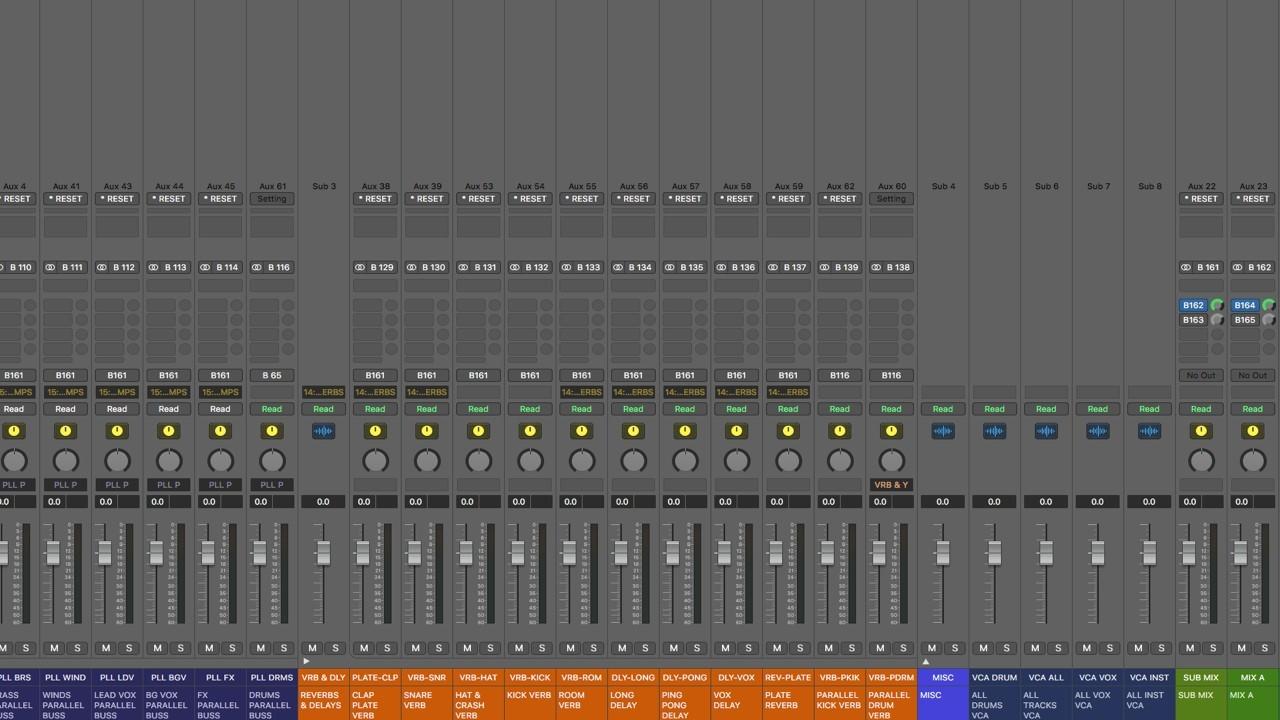
Logic Pro X: How to Create and Use VCA Faders and VCA Groups
VCA Faders and VCA Groups arrived in Logic Pro 10.1 We use them in our mixing workflow here at Next Level Sound. You might be asking, "What is a VCA Fader? Why should I use one?," or, "How do I create and use a VCA Fader?"
What Is A VCA Fader?
The VCA (Voltage Controlled Amplifier) Fader comes from the "old-school" analog mixers (those big boards in studios like the SSL consoles) and is used as a channel gain. With a VCA the engineer can control multiple faders in a group with a single fader while preserving the level of each individual channel in the group.

[ VCAs Grouped Together ]
How Does A VCA Fader Work?
First, let's look at how a Standard Fader works. The amount of audio passing through a Standard Fader is determined by the position of the Fader itself. Moving it up or down determines how much or little of the signal passes through.
The VCA component of the Fader determines how much of the audio signal (level) will flow through the VCA. The VCA Fader itself doesn't have an audio signal passing through it. The Fader sends out a control signal to each channel in the master fader group determining the change in level (Notice how a VCA Fader has no meter on it. This is because there is nothing to meter since there is no signal passing through!)

[ Track Buss Track Stack VCA Buss ]
The illustration above shows the differences between a Track Buss, Track (Summing) Stack, and a VCA Buss. The Track Buss and Track Summing Stack look identical to each other and work basically the same way. The Track Summing Stack groups a selection of tracks under a folder (stack) so that you can process the selected tracks as a group. The VCA Buss, as you can see, has no inserts, sends or meters. It has a fader and a mute and solo button.
For example, I create a VCA Drum Group which includes a Kick set at -12dB, a Snare set at -11dB and Hat set at -10dB. When I lower the Drum VCA Fader by -2dB it sends the control signal out to each of the tracks above to lower their relative level by -2dB. So after this signal is sent out the Kick will be at -14dB, the Snare at -13dB and the Hat at -12dB. The VCA Drum Fader is at -2dB. So I can use one fader to change a whole group of individual faders at one time. I still have the flexibility to go in and lower just the hat another -2dB to 14dB without affecting any other channels in the group.
So why not send the group of channels to an AUX track instead of using VCA Faders?
VCA Fader vs an Aux Track
If you send a group of tracks post-fader to an Aux track and lower the fader you will end up with a wetter signal because the gain has been reduced in the dry signal but not the wet signal.
For Example, if you send one of the tracks post-fader (post-pan) to a buss (reverb, effect, etc.) it will not be under the control of the VCA Fader. Using our previous example, when you pull down the Drum VCA Fader by -2dB the channels will be reduced by -2dB but the post-fader send will not be reduced by -2dB. This isn't what we want. We want the entire signal to be reduced (wet and dry).
The VCA Fader, on the other hand, reduces the gain on each channel so the amount of signal fed to the post-fader send is reduced as well and the dry/wet balance is maintained.
How about using Track Stacks?
VCA Fader vs the Track Stack
The Summing Track Stack acts like a VCA on the audio signal by turning down a group of tracks but only on the dry signal, not the sends. That, also isn't what we want. We are trying to control the entire signal (sends and the dry mix) from one fader.
You can use the Folder Track Stack. It functions pretty much the same as a VCA Group. It combines multiple tracks to be controlled as one unit without changing the routing of the individual tracks (just like a VCA track). Folder Track Stacks can't be grouped into other Track Stacks or VCAs.
You can create a Summing Track Stack and then put the Summing Track Stack into a Folder Track Stack. This is cool because you can use the Summing Track Stack to apply processing to the group of tracks within it and then use the Folder Track Stack as a VCA which will allow you to control the entire signal and the VCA appears. The illustration below shows the Kick VCA (Purple) including the Kick Summing Buss (Blue).
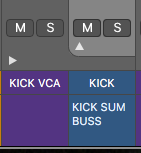
[ Kick VCA & Kick Summing Buss ]
There is a drawback to this approach. You can't group Folders. So if you had several Kicks with a Summing Stack grouped to a folder and all your percussion grouped to a Summing Stack grouped to a folder you can't further group the Kick Folder and Percussion Folder into a Drum Folder to control the gain of all drums. And you don't want to give up the functionality of the Summing Track Stack. This is why the VCA and VCA Groups are a better option.
VCA Groups
You can easily create VCA Groups with channels that are routed to different outputs. You can do this with groups and group faders. The biggest plus of using a VCA Group is VCA Groups take less CPU processing power than an AUX group, always a good thing since CPU processing power is often at a premium with big mixes.
What You Can Do With A VCA
With a VCA Fader Group, you can:
- Increase / Decrease the gain
- Solo / Mute the group
- Automate the fader
- Move the Fader to another location in the Mix Window (say next to the instrument group that is assigned to the VCA Fader)
VCA Limitations
There are a couple of limitations with VCA Faders in Logic:
- You can only automate the VCA Groups volume fader
- You can not combine VCA Group Faders into another VCA Group
So how do you create a VCA Fader Group?
Creating a VCA Fader or VCA Fader Group
There are several ways to create a VCA in Logic Pro X:
1. You can create a VCA for a channel by clicking on the blank space under VCA in the mixer window:

[ Location of VCA Channel Strip ]
Then select an existing VCA or "New VCA Fader" to create a new one:
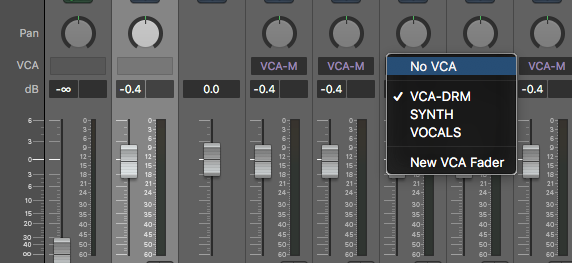
[ VCA Strip Selection ]
NOTE: If the VCA window isn't visible in the mixer, control-click (or right-click)on a track and select, "Configure Channel Strip Components" and select VCA.
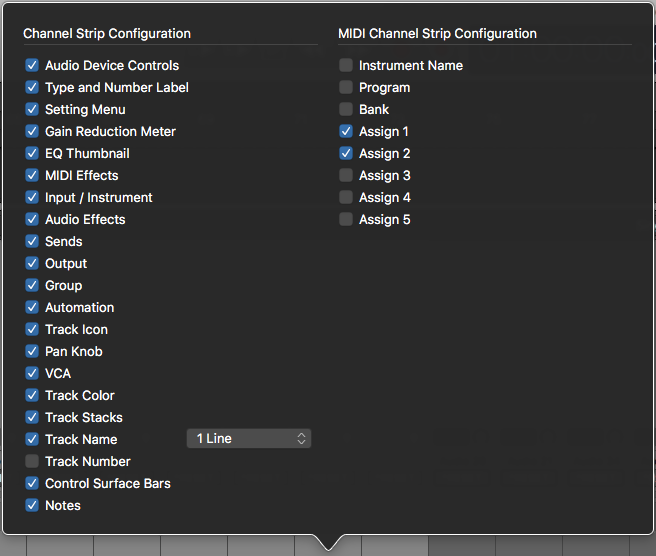
[ Configuring Channel Strip Components ]
2. You can select a group of tracks then Control-Click (or right-click) on one of the tracks and select "Create New VCA" from the menu:

[ Create A New VCA ]
The VCA Faders are created at the very end of the mixer window beyond your Master (Stereo) Buss.
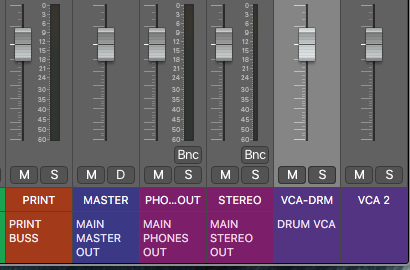
[ VCA Default Location ]
I like my VCA Faders together but before my Master Buss. First, select all the VCA Faders and then Press CONTROL-T. This turns them into tracks. To move or reorder them, go to the Arrange Window and drag them wherever you like. (I also like to create custom names like DRUM VCA, SYNTH VCA etc., rather than leaving them at their default of VCA 1, VCA 2, etc. so they are easier to find)
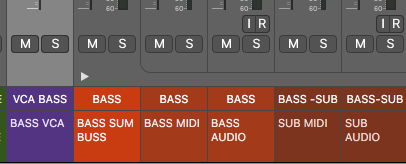
[ Location of VCA Faders ]
Some engineers like to move the VCA Fader next to the group the fader represents (see above).
What Groups Should I Create?
It is in large sessions that the VCA Fader Groups really become useful. I will often create VCA Fader Groups for drums, bass (if I am using layers), synths, strings, vocals and so on. You can create as many as you like up to 256.
TIP: If you are using a control surface you can create the number of VCA Fader Groups to correspond to the number of faders on your control surface for easy automation and adjustment.
Comments and Suggestions
Hopefully, this will encourage you to use "VCA Faders" and "VCA Groups" more often.
Author, Scott Sturgis
Please post any questions or suggestions for future topics in the Logic Pro X User Group.
Stay connected with news and updates!
Join our mailing list to receive the latest news and updates from our team.
Don't worry, your information will not be shared.


